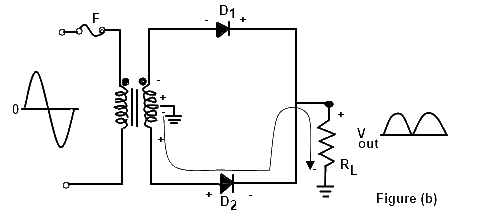Ask questions which are clear, concise and easy to understand.
Ask QuestionPosted by Nikita Yadav 5 years ago
- 1 answers
Gaurav Seth 5 years ago
A center-tapped rectifier is a type of full-wave rectifier that uses two diodes connected to the secondary of a center-tapped transformer, as shown in Figure (a). The input voltage is coupled through the transformer to the center-tapped secondary. Half of the total secondary voltage appears between the center tap and each end of the secondary winding as shown.
<figure role="group"> <figcaption>Figure (a): Full Wave Rectifier Current Path Positive Cycle</figcaption>
</figure>
<figure role="group">
<figcaption>Figure (a): Full Wave Rectifier Current Path Positive Cycle</figcaption>
</figure>
<figure role="group"> <figcaption>Figure (b): Full Wave Rectifier Current Path Negative Cycle</figcaption>
</figure>
<figcaption>Figure (b): Full Wave Rectifier Current Path Negative Cycle</figcaption>
</figure>
For a positive half-cycle of the input voltage, the polarities of the secondary voltages are as shown in Figure (a). This condition forward-biases diode D1 and reverse-biases diode D2. The current path is through D1 and the load resistor RL, as indicated. For a negative half-cycle of the input voltage, the voltage polarities on the secondary are as shown in Figure (b). This condition reverse-biases D1 and forward-biases D2. The current path is through D2 and RL, as indicated. Because the output current during both the positive and negative portions of the input cycle is in the same direction through the load, the output voltage developed across the load resistor is a full-wave rectified dc voltage, as shown.
Posted by Yash Maheshwari 5 years ago
- 0 answers
Posted by Ankita Prajapat 5 years ago
- 0 answers
Posted by Mahima P Naik 5 years ago
- 1 answers
Yogita Ingle 5 years ago
The dielectric strength of a material is a measure of the electrical strength of an insulator. It is defined as the maximum voltage required to produce a dielectric breakdown through the material.
Its SI unit is Volts per unit thickness.
Posted by Mahima P Naik 5 years ago
- 3 answers
Yogita Ingle 5 years ago
Van de graaff generator is used to generate high voltages of the order of a few million volts. This results in generation of large electric fields for experimental purposes.
Principle

- The inner sphere has a higher potential than outer if the charge q is positive.
- If the two spheres are connected through a wire, the charge will flow from high to low potential.
- Thus, providing smaller potentials at the inner sphere will keep building large amount of charge at the outer sphere, till the breakdown field of air (3 x 106 V/m) is reached.
- This accumulates close to millions of volts.
Posted by Mahima P Naik 5 years ago
- 1 answers
Yogita Ingle 5 years ago
(a)Polar Dielectric : Those substances in which the centre of positive and negative ions of molecules are not concentrated but are separated, are called polar dielectric substances. Each molecule of these substances have net permanent electric dipole moment and each molecule behaves like an electric dipole. For example, HCl molecule
In absence of an external electric field, the molecules of a polar dielectric substance are arranged in irregular manner due to thermal energy. Due to this, any volume of a substance which has molecules in large amount has zero resultant dipole moment and thus, the resultant dipole moment of the substance is zero. On placing the substance in external electric field, each molecule applies torque on the dipole that tries to align the molecule along the direction of external electric field. On increasing the electric field intensity of the external electric field, more of the molecules get align themselves in the direction of the external electric field. Thus, there is net dipole moment in the substance.
(b)Non−polar Dielectrics : Those substances in which the centre of both passive and negative charges of the molecules are coincide, are called non-polar dielectric substances. For example, H2, CO2, N2 and O2 etc. Each molecule of these substances has zero dipole moment. Thus, the net dipole moment of the whole substance is zero.
If a non-polar dielectric substance is kept in an external electric field, then the centre of the positive charge is along the electric field and the centre of the negative charge is displaced opposite to the direction of the electric field. this induces some dipole moment in each molecule.
"The induction of electric dipole moment in a dielectric substance in the presence of external electric field is called the polarization of dielectric substance.
Posted by Ramkishor Pandram 5 years ago
- 0 answers
Posted by Nikita Pundir 5 years ago
- 0 answers
Posted by Jai Karnani 5 years ago
- 3 answers
Kislay Harsh 5 years ago
Yogita Ingle 5 years ago
Electric field of an electric dipole at a point in space depends upon the position of the point.
- The dipole field at a point is inversely proportional to the cube of distance from the center to the point.
- For a very small dipole, the 2a approaches zero. This is called point dipole.

Posted by Jai Karnani 5 years ago
- 0 answers
Posted by Jai Karnani 5 years ago
- 1 answers
Posted by Jai Karnani 5 years ago
- 2 answers
Kislay Harsh 5 years ago
Posted by Jai Karnani 5 years ago
- 0 answers
Posted by Jai Karnani 5 years ago
- 2 answers
Kislay Harsh 5 years ago
Strange Men 5 years ago
Posted by Jai Karnani 5 years ago
- 1 answers
Abhi Rana 4 years, 11 months ago
Posted by Jai Karnani 5 years ago
- 0 answers
Posted by Jai Karnani 5 years ago
- 2 answers
Kislay Harsh 5 years ago
Yogita Ingle 5 years ago
According to Gauss’s law, the total of the electric flux out of a closed surface is equal to the charge enclosed divided by the permittivity. The total electric flux through a closed surface is zero if no charge is enclosed by the surface.
- Gauss’s law is true for any closed surface, no matter what its shape or size.
- The term q on the right side of Gauss’s lawincludes the sum of all charges enclosed by the surface. The charges may be located anywhere inside the surface.
- In the situation when the surface is so chosen that there are some charges inside and some outside, the electric field [whose flux appears on the left side of Eq. (1.31)] is due to all the charges, both inside and outside S. The term q on the right side of Gauss’s law, however, represents only the total charge inside S.
- The surface that we choose for the application of Gauss’s law is called the Gaussian surface. The Gaussian surface can pass through a continuous charge distribution.
- Gauss’s law is useful for the calculation of the electrostatic field for a symmetric system.
- Gauss’s law is based on the inverse square dependence on distance contained in the Coulomb’s law. Any violation of Gauss’s law will indicate departure from the inverse square law.


Posted by Drishty Kamboj 5 years ago
- 1 answers
Gaurav Seth 5 years ago
|
Wave front |
Wavelets |
|
A wave front is defined as a surface of constant phase of waves. |
A wavelet is a wave-like oscillation with amplitude which starts at zero, increases, and then decreases back to zero. |
|
if a stone is dropped in a pool of water, the waves spread out in circular rings from the point of impact. All points on such a circle are oscillating in phase. |
It can typically be visualized as an oscillation like one might see recorded by a seismograph or heart monitor. |
Posted by Mahima P Naik 5 years ago
- 1 answers
Gaurav Seth 5 years ago
Electric field at point on equatorial line of an electric dipole.
Consider on electric dipole consisting of two point-charges +q and –q separated by distance 2a.
Let P be a point at a distance r from the center of the dipole on the equatorial line, where the electric field is to be calculated.
Let E1 be electric field intensity at P due to charge –q. Therefore,
From right-angled triangle AOP, we have AP = √r2 + a2 . Therefore,
The direction of Vector E1 is along PA.
Now, let E2 be electric field intensity at P due to charge +q.
From right-angled triangle BOP, we have BP = √ r2 + a2.There fore,
The direction of E2 is along BP.
The resultant electric field Vector E is the difference of the two fields:
Thus, the electric potential due to electric dipole is zero at every point on the equatorial line of the dipole.
Posted by Ayansh Raj 1 year, 4 months ago
- 1 answers
Posted by Mahima P Naik 5 years ago
- 1 answers
Gaurav Seth 5 years ago
Consider an infinitely long thin straight wive with uniform linear charge q density λ. Let P be a point at ⊥r distance r from the wire.
To calculate the E.F E⃗ E→ at P, imagine a cylindrical Gaussian surface.
∴ The surface area of the curved part S = 2πrl
Total charge enclosed by the Gaussian surface q = λl
Electric flix through the end Surfaces of the cylinder is Φ = 0
Electric flux through the curved Surfaces of the cylinder is Φ2 = Ecosθ.s
Φ2 = E x 1 x 2πrl
The total electric flux Φ = Φ1 + Φ2
Φ = 0 + E2πrl, Φ2 = 2πrlE ………(1)
A/C to Gauss law,
from (1) and (2)
Posted by Mahima P Naik 5 years ago
- 1 answers
Gaurav Seth 5 years ago
We can find the force between any two charges by coulomb’s law, coulomb’s law states that two charged bodies will attract or repel each other with a force that proportional to the product of their masses and inversely proportional to the square of the distance between them,
Let’s get an equation out of this,
{tex}\(F\,=\,k\frac{{{Q}_{1}}\times {{Q}_{2}}}{{{d}^{2}}}\).{/tex}
Where,
F = Force of attraction of repulsion depending upon the charges
K = Coulombs constant, for air it is 9 × 10⁹ N.m²/C²
Q₁ and Q₂ are the magnitudes of two charges
d = Distance between the two charges.
Posted by Mahima P Naik 5 years ago
- 1 answers
Gaurav Seth 5 years ago
A point charge is a mathematical point having no dimensions. It can also be a spherical charged body whose entire charge can be considered concentrated at its centre.
An electric field is a field around a charge where its influence can be felt. A charge influences another charge by a force known as the electrostatic force.
Electric field intensity is a quantity that measures how strong is a field at a given point.
Thus Electric field intensity at a point is defined as the force experienced by a vanishingly small charge (known as test charge)placed at that point of the field. Electric field intensity is denoted by E and test charge by qo. Since it involves conception of force, thus electric field intensity is a vector quantity.



Posted by Mahima P Naik 5 years ago
- 1 answers
Yogita Ingle 5 years ago
According to gauss's law
The electric flux through the closed surface is 1/e times the charge enclosed by it.
Where,
e is electrical permittivity
Here,
Electric flux= q/6e
⇒1/ 6×8.85×10−12
=1.475×10−12Nm2C−1
Posted by Komal Sureshbhai Yogi Yogi 5 years ago
- 0 answers

myCBSEguide
Trusted by 1 Crore+ Students

Test Generator
Create papers online. It's FREE.

CUET Mock Tests
75,000+ questions to practice only on myCBSEguide app
 myCBSEguide
myCBSEguide
Piyush Barde 5 years ago
1Thank You